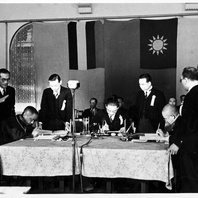
Item
Signing of Japan-Manchukuo-China Joint Declaration
Flanked by courtiers, Zang Shiyi, the Manchukuo ambassador to the RNG (seated to the left), Noboyuki Abe, Japanese ambassador to the RNG (seated to the right), and Wang Jingwei (seated in the centre) sign the Japan-Manchukuo-China Joint Declaration on 30 November 1940, through which RNG China recognised Manchukuo. The Declaration was attached to the Sino-Japanese Basic Treaty, through which Japan formally recognised the RNG. Both documents were signed within the main RNG government compound in Nanjing. The flags of Japan, China and Manchukuo are on the wall behind the men.
Read More
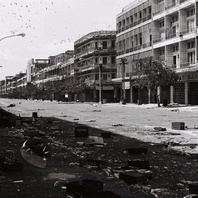
Featured Item
Empty Avenue, Phnom Penh
This photograph is part of the collection held by the Agence Khmère de Presse (AKP) and Cambodia’s Ministry of Information. This collection, which documents the early years of the People’s Republic of Kampuchea as photographed by the Vietnamese and a small team of Cambodian photographers, has not yet been classified or indexed.
Read More
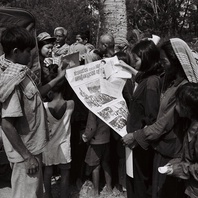
Featured Item
Villagers looking at a poster
This (probably staged) photograph shows a group of villagers looking at an illustrated poster about the Kampuchea United Front for National Salvation (KUFNS, also known as FUNSK) [Front or Renakse]. It is part of a series that describes the same group of villagers and soldiers. This photograph is part of the collection held by the Agence Khmère de Presse (AKP) and Cambodia’s Ministry of Information. This collection, which documents the early years of the People’s Republic of Kampuchea as photographed by the Vietnamese and a small team of Cambodian photographers, has not yet been classified or indexed.
Read More
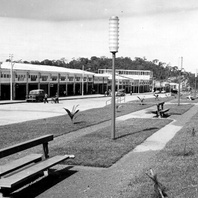
Featured Item
Commercial street in Sihanoukville
This unattributed photograph shows a commercial street in Sihanoukville town centre in the mid 1960s, with one side of the street having a promenade with benches and lampposts, and shops on the opposite side, under an arcade. The photograph is part of the collection that was donated to the National Archives of Cambodia from the Library of the Royal University of Fine Arts by Darryl Collins and Helen Grant Ross in 2003. The collection was used by Collins and Ross for their research into urbanisation. The images were probably originally used to mount the Sangkum Reastr Niyum Permanent Exhibition at the Exhibition Hall, Bassac area, Phnom Penh.
Read More
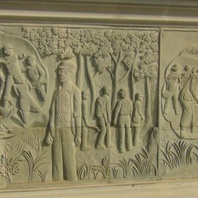
Item
Win-Win Monument bas-relief
This photograph provides a view of bas-relief on the 117-metre-long engraved base of the Win-Win Monument. It depicts the defection to Vietnam of the then Khmer Rouge officer Hun Sen in June 1977. One sees Hun Sen (dressed in Khmer Rouge garb) considering what may happen to him and his group of defectors (being killed) if they are caught by the Khmer Rouge. It also shows Hun Sen thinking about his wife who he left behind. The Win-Win Monument complex – photographed here in January 2020 – was inaugurated in December 2018 to mark the twentieth anniversary of the end of the post-Democratic Kampuchea civil war, with the final defection of the remaining Khmer Rouge factions, thanks to the DIFID policy (“Divide, Isolate, Finish, Integrate, Develop”) also known as the “Win Win” policy of Prime Minister Hun Sen.
Read More
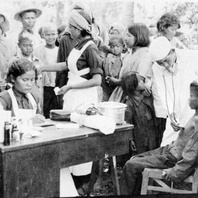
Featured Item
Medical team treating children
This unattributed photograph, showing a medical team treating children, was featured in the publication (French and English versions) entitled The People’s Republic of Kampuchea (1979). This photograph is part of the collection held by the Agence Khmère de Presse (AKP) and Cambodia’s Ministry of Information. This collection, which documents the early years of the People’s Republic of Kampuchea as photographed by the Vietnamese and a small team of Cambodian photographers, has not yet been classified or indexed.
Read More
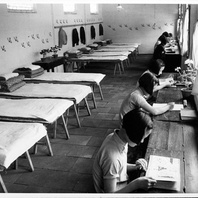
Item
Girls are all living in a dormitory [sic]
From a collection of staged photographs produced under the title “Life at a Girls School in Peking”, and produced at the Peking Jiyu Gakuen in Japanese-occupied Beijing. The original caption reads: “They are doing their ‘home works’ [sic]”.
Read More
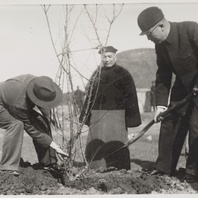
Item
Planting plum trees at Wang Jingwei’s tomb
RNG foreign minister Chu Minyi oversees the planting of young plum trees on Meihuashan (Plum Blossom Mount) in Nanjing, in the vicinity of Wang Jingwei’s tomb. The plum was (and remains) the national flower of the Republic of China, and the area around Wang Jingwei’s tomb was planted with plums as an act of patriotism after his death in late 1944. Very few photographs of Wang’s tomb survive.
Read More
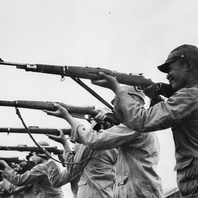
Item
RNG troops with rifles
Photograph of RNG army recruits engaged in rifle practice, possibly as part of the Rural Pacification (qingxiang) campaigns.
Read More
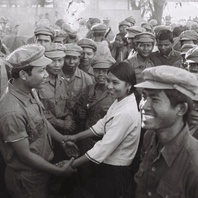
Featured Item
Brother and sister reunited
This unattributed photograph shows a brother and a sister being reunited after three years of separation. The siblings are in the centre of the image, he wearing a uniform, and she wearing what looks like festive clothing. They hold hands. The people around them, a mix of soldiers and civilians, smile broadly. The soldiers are from the Kampuchea United Front for National Salvation (KUFNS, also known as FUNSK) [Front or Renakse]. This image was featured in the publication (French and English versions) The People’s Republic of Kampuchea (1979). This photograph is part of the collection held by the Agence Khmère de Presse (AKP) and Cambodia’s Ministry of Information. This collection, which documents the early years of the People’s Republic of Kampuchea as photographed by the Vietnamese and a small team of Cambodian photographers, has not yet been classified or indexed.
Read More
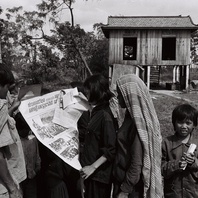
Featured Item
Village children looking at a poster
This (probably staged) photograph shows a group of village children looking at an illustrated poster celebrating the Kampuchea United Front for National Salvation (KUFNS, also known as FUNSK) [Front or Renakse]. It is part of a series that describes the same group of villagers and soldiers. This photograph is part of the collection held by the Agence Khmère de Presse (AKP) and Cambodia’s Ministry of Information. This collection, which documents the early years of the People’s Republic of Kampuchea as photographed by the Vietnamese and a small team of Cambodian photographers, has not yet been classified or indexed.
Read More
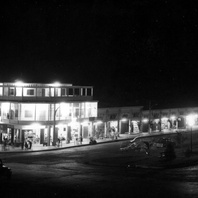
Featured Item
Commercial street in Sihanoukville by night
This unattributed photograph shows a lit building and a commercial street in Sihanoukville city centre by night. The upper floors of the two-story building at the corner are private homes. The ground floor appears to be a restaurant. The photograph is part of the collection that was donated to the National Archives of Cambodia from the Library of the Royal University of Fine Arts by Darryl Collins and Helen Grant Ross in 2003. The collection was used by Collins and Ross for their research into urbanisation. The images were probably originally used to mount the Sangkum Reastr Niyum Permanent Exhibition at the Exhibition Hall, Bassac area, Phnom Penh. This specific photograph was used as an illustration to an article entitled “The seaport of Sihanoukville was a vital necessity for the kingdom” by Jacques Fabre in the monthly pictorial Kambuja, no. 4 (15 June 1965): 65.